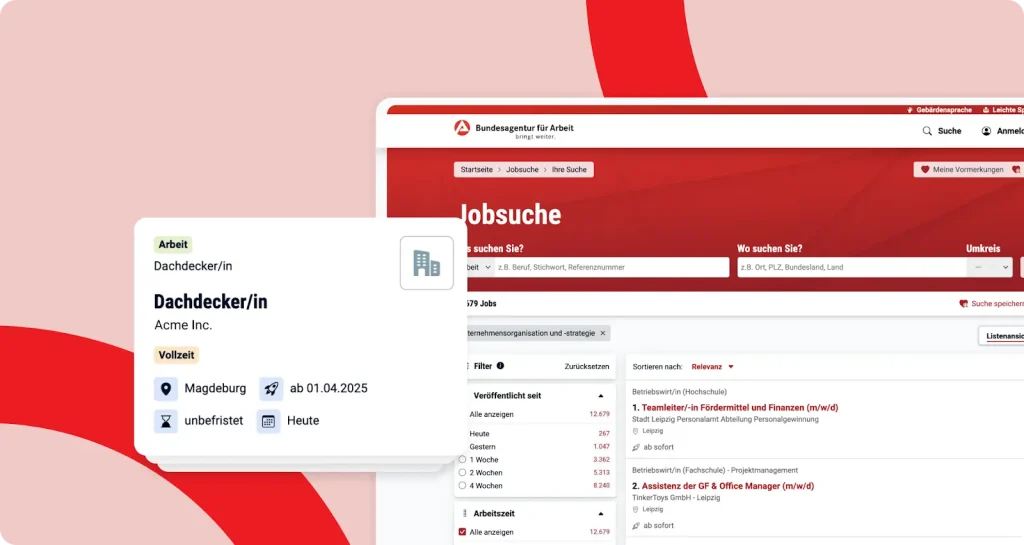Remote work vs. hybrid work: Which model is best for your office?
Being able to work remotely from anywhere at any time is a trend that appeals to more and more companies and their employees. However, many companies still find it rather difficult to let their staff work completely from home or on the road …
Table of contents
… and therefore strive for a mixture of face-to-face and remote work, i.e., a hybrid working model. In this article, we explain how hybrid and remote models work and what challenges you and your (remote) workers may face.
- What does remote work mean?
- What are the requirements for remote work?
- What are the pros and cons of remote work?
- What is hybrid work?
- Pros and cons of hybrid vs. remote work (or office only work)?
What does remote work mean?
Before diving deeper into the differences between hybrid and remote work—and what challenges you may face when implementing these models—we need to define each model in a bit more detail.
So what does remote work actually mean? “Remote” means working decentralised and thus spatially divided in a place that is not the company office. Quite often, companies that are completely remote work-oriented do not even own a central office.
The work, however, does not necessarily take place in the home office, but for example in a workspace, on the train, in the park, on the beach or anywhere else in the world.
Requirements for remote work
What are the requirements to enable remote working? Below, we give you a brief overview of the essential requirements for working remotely:
Tasks can be completed entirely online
Whether the remote model is an option for a company primarily depends on the possibility of completing the tasks completely online and from anywhere in the world. For pure office work, this is possible in most cases.
Remote work is therefore particularly widespread and sought after in the areas of administration, marketing, design, consulting, finance and IT. Employees don’t need to be in the office and talent can therefore be attracted from – and working – all over the world.
Connection to the World Wide Web
Since remote work takes place online, a fast and stable, but also secure connection to the internet is required. If workers are not in the home office, a cellular connection to the internet is necessary.
Compliance to data protection requirements
While many tasks can at least theoretically be processed online, data protection (GDPR) must also be taken into account. In some cases, data must be processed strictly offline due to internal company or legal regulations on data protection. In this case, it is possible to work remotely, but only via Virtual Private Network (VPN—usually bound to the home office).
Outstandingly effective corporate communication
The fact that anyone can work from anywhere and at any time creates various obstacles – such as time differences — and makes corporate and team communication much more difficult. For this reason, a very well organised communication structure and fixed guidelines for employees are indispensable for effective remote work.
Pros and cons of remote working
Before moving on to hybrid work, let’s quickly take a look at the pros and cons of remote working. Even though the remote model offers numerous advantages at first glance, there is also a shadow side of challenges you and your remote workers might face that should not be overseen.
Advantages
Remote working is one of the most sought-after employee benefits these days, and those who offer this modern type of workplace are scoring points in regard to their employer branding. Companies with remote jobs can also look forward to these advantages:
- International talent pool
Vacancies are no longer location-based, opening the way for global recruitment. So talent can be recruited from all over the world to join and be integrated into the team without the stress of relocation and complex integration programmes. - Less stress, higher productivity
The daily commute alone costs many employees several hours and leads to additional stress and reduced performance. With remote workstations, the commute is usually eliminated completely and allows for a much more relaxed approach to daily business. Even a few days of not having to commute can already have a positive impact (more on this below when we talk about hybrid work). Those who are more relaxed can also achieve more, so productivity increases considerably. - Better work-life balance, better staff retention
The travel and commuting time saved also means additional time that employees can invest in family, friends, and hobbies and thus better reconcile work and private life. This optimised work-life balance provides additional satisfaction and strengthens employees’ loyalty to their employers, improving your employee retention rate. - Resource savings
If you don’t have to maintain office space, you naturally save a lot of money on rent, electricity, heating and up-keeping. Instead, you can invest in other essential areas of the company—for example, in the health of the employees and the ergonomic equipment of their remote workplaces. - Sustainable
Maintaining a central corporate location not only consumes resources, it also contributes to increasing CO2 emissions in many ways—whether through high electricity consumption, waste generated, or travel between home and office. Since remote working completely eliminates all of this, it is currently probably one of the most environment-friendly working models of our time and also scores points with environmentally conscious employees as a result. - Infection control
Another practical advantage of remote work: If easily transmissible viruses (e.g., influenza or corona) or bacteria (e.g., enterococci or staphylococci) are circulating, remote work provides excellent services in the area of infection control. Because if your employees don’t meet, they can’t infect one another.
Disadvantages
And now for the disadvantages of remote working. Before mobile working takes its course, it is essential to find and implement solutions to the following problems:
- Not suitable for each and every job
Whichever way you look at it: remote work is not universal. What works for office jobs rarely works for production and maintenance areas where the work is done with machinery or requires special equipment. - Difficult onboarding
It is well known that the best way for new team members to grow into new jobs and roles is for them to be thoroughly instructed and trained in the typical processes — and this is best done on site and in direct contact with their new team colleagues. Unfortunately, this is not possible with remote onboarding, so the important social component is missing. This can have a negative impact on working morale. - Complicated team building
Decentralised remote work can be carried out from anywhere in the world. However, the resulting (sometimes extensive) physical separation of team members can also have a serious impact on team spirit. However, regular meetings are difficult to implement with international team members. For more information on this topic, check out our guide on building a stronger remote culture. - Sense of isolation among employees
Working far away from team colleagues also creates a sense of isolation for many remote workers. The Corona pandemic has made it very clear that home offices can make people lonely and ill. The consequences of the lack of social contact between remote workers should never be underestimated. - Complex communication
Remote work is usually accompanied by a wide variety of working time models. Especially when different working hours cover different time zones, it is never possible for all employees to be online at the same time. Of course, this can make communication extremely difficult and slow down productivity. - Distraction due to external factors
Those who have children or pets around them during working hours or work in particularly exotic locations run a greater risk of being distracted by them. The separation of work and leisure time also becomes much more difficult and can drag down concentration and productivity quite a bit … Without a high degree of discipline and regular performance reports, profitable remote work is hardly achievable. However, this again clashes with the employees’ desire for trust from their employers.
Remote working is consequently not ideal for everyone. But as the Great Resignation has taught us anything, it’s that employees are now more demanding than ever when it comes to flexibility in their working life. In fact, offering flexible working models is one of the main ways you can get employees back to the office post-COVID-19.
But employers might be sceptical to offer fully remote working options. After all, many employees and employers have had the painful experience of poorly organised remote work during the COVID-19 pandemic and are constantly struggling with the consequences. And that’s where hybrid work offers an alternative to remote work.
Hybrid work: the win-win solution?
You don’t want to send your employees to full-time home offices, but you still want to offer them the option of remote working? Then “hybrid work” is a great option, because here your employees can decide for themselves when, how and from where they want to work.
Employees who prefer the concentrated office atmosphere, don’t want to miss out on the social component or need to discuss project-related matters can thus come to the office at any time. Others, however, can decide to work from home (or somewhere else) if they prefer to do so instead.
Sub-types of hybrid work
Note that employers often limit the granted remote days per week, as to prevent permanent remote absence and enforce (semi-) regular attendance.
In fact, there are several subtypes of the hybrid work model. A distinction is made between six variants that give you a rough orientation of what this modern workplace arrangement could look like in your company:
- Fully decentralised:
Strictly speaking, this variant does not represent a hybrid model, but merely another name for “completely remote” — i.e., all outside the office. - Remote first:
In this form, work is mainly done from home office/outside the office and there are no requirements regarding presence in the office. Of course, occasional work in the company office is still possible. - Static hybrid working:
Here, your employees decide once whether they want to set up their workplace in their home office or in the corporate office – and then stay there permanently. In this way, usually only some employees opt for remote work, while others prefer to come to the office every day. - Dynamic hybrid working:
In the dynamic version of hybrid work, team members decide for themselves on which days and times of day they work in the office or at home. This means that there is a constant fluctuation within the office staff, but it is of course also possible to make specific appointments for meetings and the like. - Synchronous hybrid working:
The second last type of hybrid work refers to a system in which teams work synchronously according to the same, often predefined schedule in the corporate or home office, i.e., either the whole team is present or no one is. - Office first:
This variation is the counterpart to the remote-first arrangement: here the office is the principal workplace, but work may occasionally be done from home.
Pros and cons of hybrid vs. remote work (or office-only work)
Hybrid working also brings both advantages and disadvantages. Let’s take a closer look at these now:
Advantages
- Maximum flexibility meets self-determination
There are days when a visit to the office is more convenient (example: project kick-off, hot phases of a project) and days that are better handled from the home office – for example, when craftsmen or eagerly awaited parcels are expected. However, no one wants to be forced into a working model that does not suit them. Your employees will therefore greatly appreciate the flexible working and self-determination options. - Higher productivity
While some can only really get things done in the office, others are much more concentrated and productive at home. With a hybrid work model, you cover both groups and thus increase/maintain the productivity of all employees without having to send them to an unfamiliar working environment. - Lower office expenses
If the office is only occupied intermittently and on a rotating basis, this reduces the number of workstations required within the company office — and thus also the cost of maintaining and servicing the office space. - Office onboarding possible
New team members need to be trained? With the hybrid work model, this is also possible on site without any problems. Newcomers can thus settle into the corporate culture and the new work processes much more quickly, and will feel better integrated as a result. - Reduced risk of infection
Another view from the field of infection control. After all, if not all team members are present at all times, only parts of the team can come into contact with viruses and bacteria, but never the entire workforce. - Reduced travel costs for staff
Employees who travel by car benefit from hybrid working through lower travel costs, as they do not have to make the journey to work every day. This leaves some with a few euros left over each month that can instead be invested in hobbies, leisure time or fulfilling smaller wishes.
Disadvantages
- Sense of isolation among remote workers
In a hybrid team, especially with static hybrid work, a feeling of exclusion can quickly arise if sufficient connection to the in-house team is not ensured. - Commuters still have to commute
Even though this may not be the case on a daily basis, commuting to work is still a regular occurrence. Especially in cities with high traffic volumes, this consumes a lot of time, causes stress and can negatively affect the performance of those concerned. - Higher risk of burnout
Remote workers are often under pressure in hybrid working, or worried about being considered lazy in comparison to the in-house team. This can lead them to work more overtime and take fewer breaks than their office colleagues – ultimately putting themselves at greater risk of burnout. - Changed requirements for office space
Hybrid employees use offices in a multifunctional way: as a place for relaxed encounters, for concentrated work, or also for important team and project meetings. In order to provide a focal point for all usage purposes, the premises should be divided into flexibly usable meeting rooms, focus areas and communal areas.
Conclusion
Are you still looking for a suitable working model for your company? Remote working allows you to work from anywhere in the world. If you opt for the remote model, you save on office costs, but have to invest a lot in team-building and communication.
In addition, you risk health consequences for all those who are simply not suited to work in a home office and cannot perform efficiently there. Hybrid working is much less complicated and more flexible, because here everyone gets what they are best at.
However, which form of work is right for your company depends on the type and industry as well as the individual needs of your company and your employees. Together, reasonable compromises between your interests and the wishes of your employees can usually be found here.
Sarah Heßler
Sarah Heßler was a bilingual Content Manager at JOIN who loved to share knowledge with our visitors and enjoyed writing about HR and Recruitment topics from many different perspectives.




